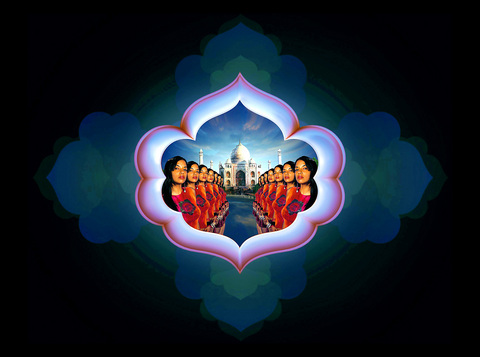On a fine spring day in Manhattan, Reshma Taufiq, 28, was the first to audition for a role on a new MTV channel that will be aimed at second-generation desis, or immigrants from the Indian subcontinent. Her emerald-green bodice fit snugly atop navel-baring jeans, and her long black hair curtained her cheekbones as she sweated under the studio lights, trying sexy, then cheery, then exuberant variations on "Live from Jackson Heights, Queens, it's MTV Desi."
Taufiq summed herself up: R&B artist who is bilingual in English and Hindi; news reader for a local ethnic channel on which she conducts phone-in quizzes on Bollywood trivia; frequenter of the late-night desi party scene who thinks that arranged marriages are not such a bad idea; and, well, chemical engineer now working in software development at Hewlett-Packard.
Azhar Usman, 29, with his knitted skullcap and full beard, presented somewhat differently. An MTV executive, he explained, had recruited him, saying, "We're going to redefine the identity of the MTV host. It doesn't have to be someone sexy and good-looking." A comedian (and lawyer) from Chicago, Usman used the audition to invent an exaggeratedly accented (and quite amusing) character: Vijay the VJ.

PHOTO: NY TIMES
Most of the applicants thanked MTV for thinking of them as a demographic ready for a music-video channel all its own. "It's so nice to be recognized," said Tara Austin, a Sri Lankan-American from Los Angeles. "I am just an American girl at the end of the day, but I have a strong South Asian background. I eat with my hands, you know? We're, like, so hungry for hearing our own culture."
Hybrid Channel
That's what MTV World is counting on as it introduces three new channels focusing on the growing population of young, acculturated Asian-Americans: first, MTV Desi, which will go on the air in late July; then MTV Chi, for Chinese-Americans, by the end of the year; and MTV K for Korean-Americans next year.

PHOTO:NY TIMES
The channels will not be merely tweaked reproductions of MTV India, MTV China or MTV Korea, three of MTV's 42 channels abroad. Rather, they will, like their target audiences, be hybrids, blending here and there and grappling with identity issues, mostly in English.
MTV Desi will serve as the prototype. Interspersed among Bollywood videos, electronic tabla music and English-Gujarati hip-hop, it will feature brief documentary clips profiling desis, comic skits about South Asian-American generational conflicts, interviews with bicultu-ral artists and desi house parties, live. MTV Chi will mix up Mandarin rock, Canto pop and Chinese-American rap; MTV K will tap into South Korean hip-hop and the little-known but vibrant Korean-American pop scene. MTV Desi will start on satellite nationally and then move to digital cable systems in various parts of the country.
MTV World's premise for these new channels was commonsensical: that young bicultural Americans have tastes different from those of youths in their ethnic homelands and therefore need, as it were, a customized MTV.
In that premise lay a confluence of academic and commercial thinking. For at least a decade, academics have explored the idea that many immigrants possess "transnational" identities. That is, aided by jet travel, technology and global commerce, they -- and their children -- maintain vital, current links to homelands that are never really left behind. There has been a fervent debate in intellectual circles about the "cultural space" inhabited by the children of recent immigrants and to what extent its very "hybridity" makes it a place of its own.
MTV's exploration was less theoretical: market research through house parties and minigroups involving Asian-Americans in New York and Los Angeles. MTV concluded that second-generation immigrants not only desire their own age-appropriate connection to their parents' homeland but that they also passionately want to see their struggle to define themselves as hyphenated Americans mirrored on television.
"If you're a young Chinese-American or Indian-American, what channel do you tune into to see yourself, to see artists that reflect your lifestyle?" asked Nusrat Durrani, 44, senior vice president and general manager of MTV World. He has an almost missionary zeal about this project, but then, as a native of Lucknow, India, who now lives in Brooklyn, he has a firsthand view of hybrid life. As he sees it, the Asian-American population, which is booming, is also coming of age. "This country has had the African-American experience, the Hispanic-American experience, and now it is the time for the third-largest group, the Asian-Americans," he said.
The Asian-American population grew to 12.3 million in 2004 (or 14 million, when including Asians of mixed race) from 6.9 million in 1990, according to the Census Bureau. The three target audiences for the new MTV channels, especially Indian-Americans, are better educa-ted and more affluent than average Americans, according to the census. The median family income of an Asian Indian in the US was US$70,708 in 1999, compared with US$50,046 for all Americans; 64 percent held at least a bachelor's degree, compared with 24 percent for all American families.
Untapped Markets
Still, Durrani said, "The Asian-American experience has not been articulated on the national stage, although there are these incredibly vibrant subcultures, artists from all these communities who are entirely untapped."
Enter MTV, ready to give these artists a platform, to "super-serve" the young ethnic populations of the US and, then, perhaps, to entice young Americans of all backgrounds to tune in and check out a universe, cultural and musical, that they know little about.
These channels won't live or die by the size of their crossover audience, said Van Toffler, president of MTV Networks, a division of Viacom. Initially MTV will be supplementing an investment of what he called "several millions" with some programming from MTV UK, MTV India and other international MTVs.
But there is nonetheless the hope that these channels will reach beyond their niche audiences, meaning that MTV, which has long exported American pop culture to the world, is trying to import global pop culture into the US.
When MTV began to establish channels abroad in the late 1980s, critics viewed the expansion as quintessential cultural imperialism that would homogenize youth culture worldwide. Early on, though, MTV learned that it made better business sense to be "glocal" -- their motto is "think global, act local" -- than to impose a wholly American cultural product. Young people, wherever they were, would watch international acts for only so long before they wanted to see something of their own. So each of MTV's international channels developed local talent and its own personality: MTV Indonesia has a call to prayer, MTV Italy has cooking shows, MTV Brazil is extremely colorful and, sartorially speaking, quite bare.
Still, the MTVs around the world share that distinctive, hyperkinetic MTV footprint, and they are profoundly commercial, and not always profoundly artistic, enterprises. So some second-generation immigrants are leery of MTV's zeroing in on their market potential.
One young woman hoping to be a VJ, Niharika Desai, 27, declared during her interview that she had auditioned partly out of curiosity to see "what corporate America thinks of me."
Her comment met poker faces from Durrani, who that day wore all black and studded jewelry, and Lem Lopez, a Filipino-American executive producer for MTV World, who wore his long hair in a slipknot atop his head and his floral shirt loose and half unbuttoned.
"Not that you're corporate," Desai said to them, pedaling backward. "I know that you're a kinder, gentler version of the Man."
Projecting a kind of perky punk aesthetic, Desai wore her hair shaggy, with a streak of blond, her jeans folded up and her Converse sneakers faded. A video editor who grew up in upstate New York, she verbally motored on, trying to make amends, sort of.
"My whole thing coming here, it's really cool that there's going to be a desi channel," she said. "I also have some thoughts. Growing up, I became who I am more from influences in Poughkeepsie than from the Indian community. My parents didn't raise me watching Hindi films and what not. So I implore you, please do something more than Bollywood." Actually, she punctuated Bollywood with an expletive, and then again when she clarified: "Don't get me wrong. I love Bollywood. But desi kids in America would so benefit from having a cool influence and learning hip stuff, too, like MIA."
Desai was referring to Maya Arulpragasam, a Sri Lankan-English performer who goes by the stage name MIA. Clearing his throat, Durrani, who seemed to be charmed by Desai's irreverence, said simply: "I want to put you completely at ease. This isn't corporate America. And MIA is so central."
MIA is the daughter of a Tamil militant whose family fled the violence in Sri Lanka and eventually settled in a housing project outside London. There, she said in an interview that will be shown on MTV Desi, she started over as refugee "scum," with hand-me-down clothes, in special schools, on the lowest rung of the English social ladder.

US President Donald Trump may have hoped for an impromptu talk with his old friend Kim Jong-un during a recent trip to Asia, but analysts say the increasingly emboldened North Korean despot had few good reasons to join the photo-op. Trump sent repeated overtures to Kim during his barnstorming tour of Asia, saying he was “100 percent” open to a meeting and even bucking decades of US policy by conceding that North Korea was “sort of a nuclear power.” But Pyongyang kept mum on the invitation, instead firing off missiles and sending its foreign minister to Russia and Belarus, with whom it

When Taiwan was battered by storms this summer, the only crumb of comfort I could take was knowing that some advice I’d drafted several weeks earlier had been correct. Regarding the Southern Cross-Island Highway (南橫公路), a spectacular high-elevation route connecting Taiwan’s southwest with the country’s southeast, I’d written: “The precarious existence of this road cannot be overstated; those hoping to drive or ride all the way across should have a backup plan.” As this article was going to press, the middle section of the highway, between Meishankou (梅山口) in Kaohsiung and Siangyang (向陽) in Taitung County, was still closed to outsiders

President William Lai (賴清德) has championed Taiwan as an “AI Island” — an artificial intelligence (AI) hub powering the global tech economy. But without major shifts in talent, funding and strategic direction, this vision risks becoming a static fortress: indispensable, yet immobile and vulnerable. It’s time to reframe Taiwan’s ambition. Time to move from a resource-rich AI island to an AI Armada. Why change metaphors? Because choosing the right metaphor shapes both understanding and strategy. The “AI Island” frames our national ambition as a static fortress that, while valuable, is still vulnerable and reactive. Shifting our metaphor to an “AI Armada”

The Chinese Communist Party (CCP) has a dystopian, radical and dangerous conception of itself. Few are aware of this very fundamental difference between how they view power and how the rest of the world does. Even those of us who have lived in China sometimes fall back into the trap of viewing it through the lens of the power relationships common throughout the rest of the world, instead of understanding the CCP as it conceives of itself. Broadly speaking, the concepts of the people, race, culture, civilization, nation, government and religion are separate, though often overlapping and intertwined. A government